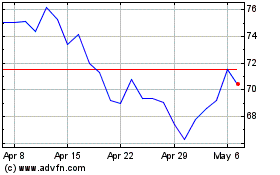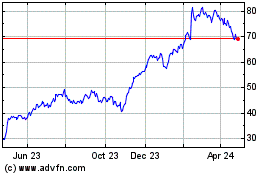Is it Worth Investing in Unprofitable Companies? We Ran the Numbers -- Journal Report
March 08 2020 - 11:36PM
Dow Jones News
By Derek Horstmeyer | Graphics by Vanessa Qian
Uber, Pinterest, Peloton, Lyft, Snap -- the list of unprofitable
companies trading on U.S. exchanges is a long one.
In fact, of listings on the New York Stock Exchange and Nasdaq
with at least one year of the relevant earnings data, more than 35%
were unprofitable in their cumulative results for the four quarters
ended Sept. 30, 2019.
While some of these unprofitable companies may be perceived as
disrupters of future business and embraced by certain investors,
most of their shareholders probably don't fully realize the set of
risks they are taking on. Indeed, while there will always be
investors who wind up looking smart for investing in, say, an
Amazon.com, when the chips were down, in most cases the stocks of
unprofitable companies eventually head in one direction: lower.
These companies exhibit greater risk than profitable companies
across the board: Their shares on average return less, are more
volatile and are prone to a type of risk more typically associated
with bonds -- interest-rate risk.
Taking the full set of all NYSE- and Nasdaq-listed companies
disclosing earnings for the past five years, and using the
cumulative net income over the prior four quarters in a given year,
I deemed those with positive net income as "profitable," and those
with negative net income as "unprofitable." To avoid any look-ahead
bias in the data, measures of profitability were based on the year
preceding the start date of any one-year stock returns
calculated.
First, the shares of unprofitable companies have vastly
underperformed those of profitable companies over the past five
years. No surprise there. Among the profitable companies, the
median annualized share return was 16.0%, compared with 4.2% for
the unprofitable firms. This amounts to an annualized difference of
11.8 percentage points.
That the average share return of the unprofitable companies was
positive at all will perhaps surprise some. But this can be
attributed to two things: One, there are a lot of shareholders who
don't want to miss "the next big thing," so they bet on the
riskiest companies; and two, markets are imperfect.
Next up, volatility. Unprofitable companies as a group were far
more volatile than their profitable counterparts. In fact,
volatility for the unprofitable companies was twice as high as it
was for the profitable companies over the past five years (standard
deviation in returns of 59.3% v. 29.2%).
And, finally, interest-rate risk, or, how returns were affected
each time the Fed raised rates. Most equity investors don't pay
that much attention to this data point. Rate increases typically
have more direct consequence for bond investors; when interest
rates rise, the value of bonds purchased earlier tends to fall. For
stocks, meanwhile, although rate increases tend to be seen as
putting an immediate drag on earnings in general, for the five
years I studied, the unprofitable companies showed 50% greater
interest-rate risk than profitable ones.
To be precise, for the 30 days following each of the nine rate
increases in the past five years, the returns of unprofitable
companies fell an average of 2.2%, compared with 0.8% for
profitable companies. This highlights that unprofitable companies
are much more sensitive to Fed rate increases than profitable
compares are.
All in all, even though younger investors might like these
unprofitable companies, the historical evidence paints a much
bleaker picture -- greater interest-rate risk, volatility and
general underperformance all add up to not the best thing to add to
one's portfolio.
Dr. Horstmeyer is an associate professor of finance at George
Mason University's Business School in Fairfax, Va. He can be
reached at reports@wsj.com.
(END) Dow Jones Newswires
March 08, 2020 23:21 ET (03:21 GMT)
Copyright (c) 2020 Dow Jones & Company, Inc.
Uber Technologies (NYSE:UBER)
Historical Stock Chart
From Mar 2024 to Apr 2024

Uber Technologies (NYSE:UBER)
Historical Stock Chart
From Apr 2023 to Apr 2024
